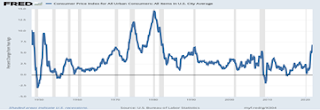Firstly, home builders are beginning to play catch up with the housing shortage that has plagued those wanting a place to live since the end of the Great Recession and busted housing bubble. That’s when construction ground to a halt because one million more homes were built than were needed at the time.
Does this mean the housing market could begin a decade-long recovery as has happened in the past? It’s possible. Consumers are flush with cash from the pandemic aid and the personal savings rate is still at a post-recession high (6.9 percent).
More than 1,800,000 housing units per year were constructed during the height of the housing bubble in 2006 (see below graph), which fell to just 400,000 units annually during the Great Recession in 2008 (gray bar), which is part of the reason for the current housing shortage.
The last two recoveries lasted approximately 10 years. So why not toast the possibility that this may be a housing recovery that might last, if the other roadblocks to a housing recovery, labor material shortages should ease next year?
Construction is booming, which should begin to fill the very low inventory of homes for sale, despite the labor and material shortages.
“Single‐family housing starts in November were at a rate of 1,173,000; this is 11.3 percent above the revised October figure of 1,054,000. The November rate for units in buildings with five units or more was 491,000,” according to the Census Bureau.
Rising existing-home sales are helping to fill the housing need. Existing-home sales rose 1.9 percent to a seasonally adjusted annual rate of 6.46 million in November, the National Association of Realtors said Wednesday. That is the third straight monthly gain. And there is room to grow more sales.
More than 7 million existing homes were sold in 2005 at the height of the housing bubble, per the above existing-home sales graph but sales declined to 4 million in 2008 during the Great Recession (gray bar in graph).
Unsold inventory is at a 2.1-month supply in November, the lowest since January. That’s down from 2.3 in the same month last year, and a 4 to 6 month supply of homes for sale during more normal times.
“Supply-chain disruptions for building new homes and labor shortages have hindered bringing more inventory to the market,” said NAR chief economist Lawrence Yun. “Therefore, housing prices continue to march higher due to the near record-low supply levels.”
There’s better economic news as well that may help to cure the housing crunch. Third quarter GDP growth was revised up slightly to 2.3 percent, and Q4 growth is projected to be even higher.
Consumer confidence is also on the rise again with the holidays. The index of consumer confidence rose to 115.8 in December from a revised 111.9 in the prior month, The Conference Board said Wednesday.
Lynn Franco, Senior Director of Economic Indicators at The Conference Board said, “The Present Situation Index dipped slightly but remains very high, suggesting the economy has maintained its momentum in the final month of 2021. Expectations about short-term growth prospects improved, setting the stage for continued growth in early 2022. The proportion of consumers planning to purchase homes, automobiles, major appliances, and vacations over the next six months all increased.”
So this is the best time to raise a toast to a continued housing recovery—and a Happier New Year!
Harlan Green © 2021
Follow Harlan Green on Twitter: https://twitter.com/HarlanGreen











